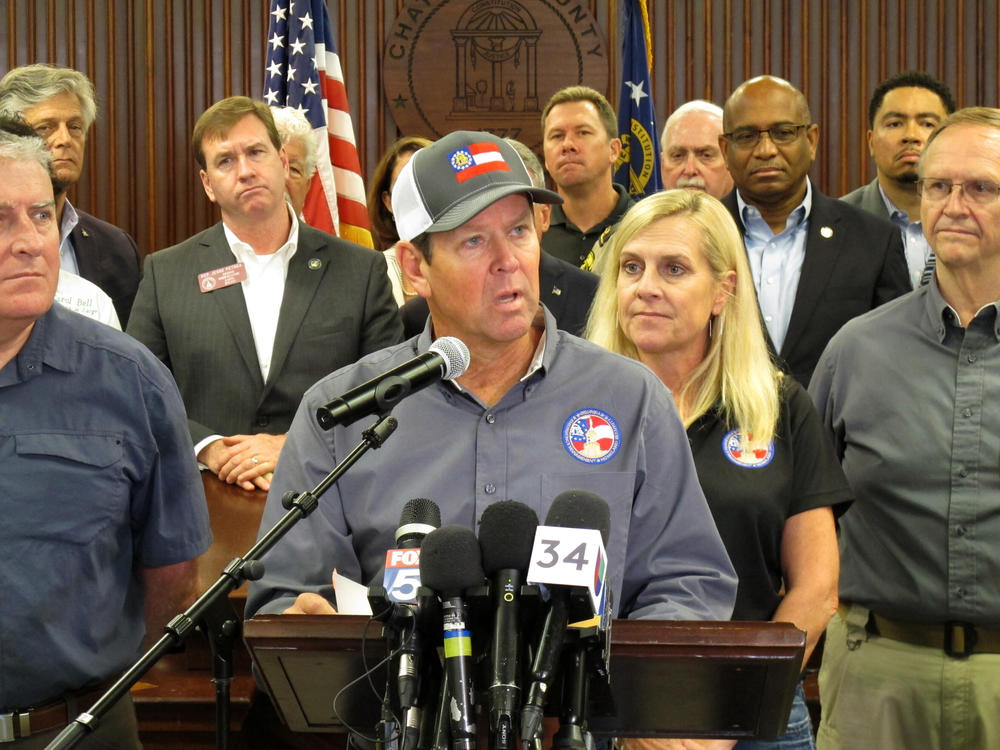Section Branding
Header Content
Kemp: Hurricane Dorian ‘Expected To Remain Very Powerful’ As It Approaches Georgia Coast
Primary Content
While the exact path Hurricane Dorian will take up the Atlantic coastline is uncertain, the message from Gov. Brian Kemp and other state officials remains the same: if you live on the coast, evacuate.
About 400,000 Georgians who live east of I-95 are under mandatory evacuation orders as the storm looming off the Florida coast continues its slow churn.
Speaking at an afternoon briefing, Kemp said that Dorian “is expected to remain very powerful” as it reaches the Georgia coast, with winds currently forecasted at 40 to 60 mph and storm surge of 3 to 6 feet along the coast.
RELATED COVERAGE: Officials Urge Georgians to Heed Warnings Ahead Of Hurricane Dorian
Additionally, there are concerns of flash floods — Kemp said he noticed water levels were very high during his visits to Savannah, Brunswick and other coastal areas Monday.
“We are asking everyone to please heed those warnings and evacuate if at all possible, given the risks of strong winds and potential flooding in these areas,” he said. “If coastal residents decide not to evacuate – and I want to be very clear – they will be on their own if first responders are unable to reach them.”
Georgia Emergency Management and Homeland Security Agency director Homer Bryson said public health officials in coastal counties have worked to evacuate patients and other residents who may not be able to evacuate on their own.
Already, parts of Camden and Glynn counties are under a hurricane watch, and more areas are likely to be added as the storm’s path becomes more clear.
Savannah city officials have instituted a curfew beginning 9 p.m. Tuesday to 6 a.m. Wednesday. Mayor Eddie DeLoach said people should heed evacuation orders and that many have learned from recent storms like Hurricane Matthew in 2016.
Kemp praised the work of state and local officials in implementing the evacuation plan and other storm response, adding that an early disaster declaration and support from the White House has allowed various resources to be in place ahead of the storm’s impact, whatever that may be.
“I believe these measures will greatly assist with ongoing storm prep and disaster response efforts, but we still have much work to do,” Kemp said.
The governor issued an executive order on Monday that authorized the state Department of Defense to mobilize up to 2,000 Georgia National Guardsmen to assist with storm preparation, response and recovery efforts.
Tonight I've issued an Executive Order authorizing GA Department of Defense to provide up to 2,000 GA National Guardsmen for #Dorian prep, response & recovery. Adjutant General Carden is now empowered to call up Guardsmen to State Active Duty upon request of @GeorgiaEMA. #gapol pic.twitter.com/BiWG5RPnHq— Governor Brian P. Kemp (@GovKemp) September 2, 2019
In addition to the mandatory evacuation orders, traffic on I-16 will be reversed to accommodate the evacuations beginning at 8 a.m. Tuesday, running from Savannah through U.S. 441 in Dublin.
All four lanes of the interstate will run westbound, but the Georgia Department of Transportation is also encouraging evacuees to take alternate routes as well.
“We urge the public to heed all warnings and evacuation orders, Georgia Department of Transportation commissioner Russell McMurry said in a statement. "As we saw with Hurricane Matthew in 2016, a hurricane doesn’t have to make landfall in an area to produce significant impacts. This is about safety, not speed. We ask that everyone plan ahead, pre-select your evacuation route using 511, carry needed supplies and exercise patience and discretion. We’re all in this together.”
Dorian was downgraded from a Category 5 storm Monday after unleashing massive flooding across the Bahamas. Officials there say at least five people have died in the Abaco Islands, where “the strongest hurricane in modern records” made landfall on Sunday.
<!-- The following message will be displayed to users with unsupported browsers: -->Your browser does not support the <code>iframe</code> HTML tag. Try viewing this in a modern browser like Chrome, Safari, Firefox or Internet Explorer 9 or later.



